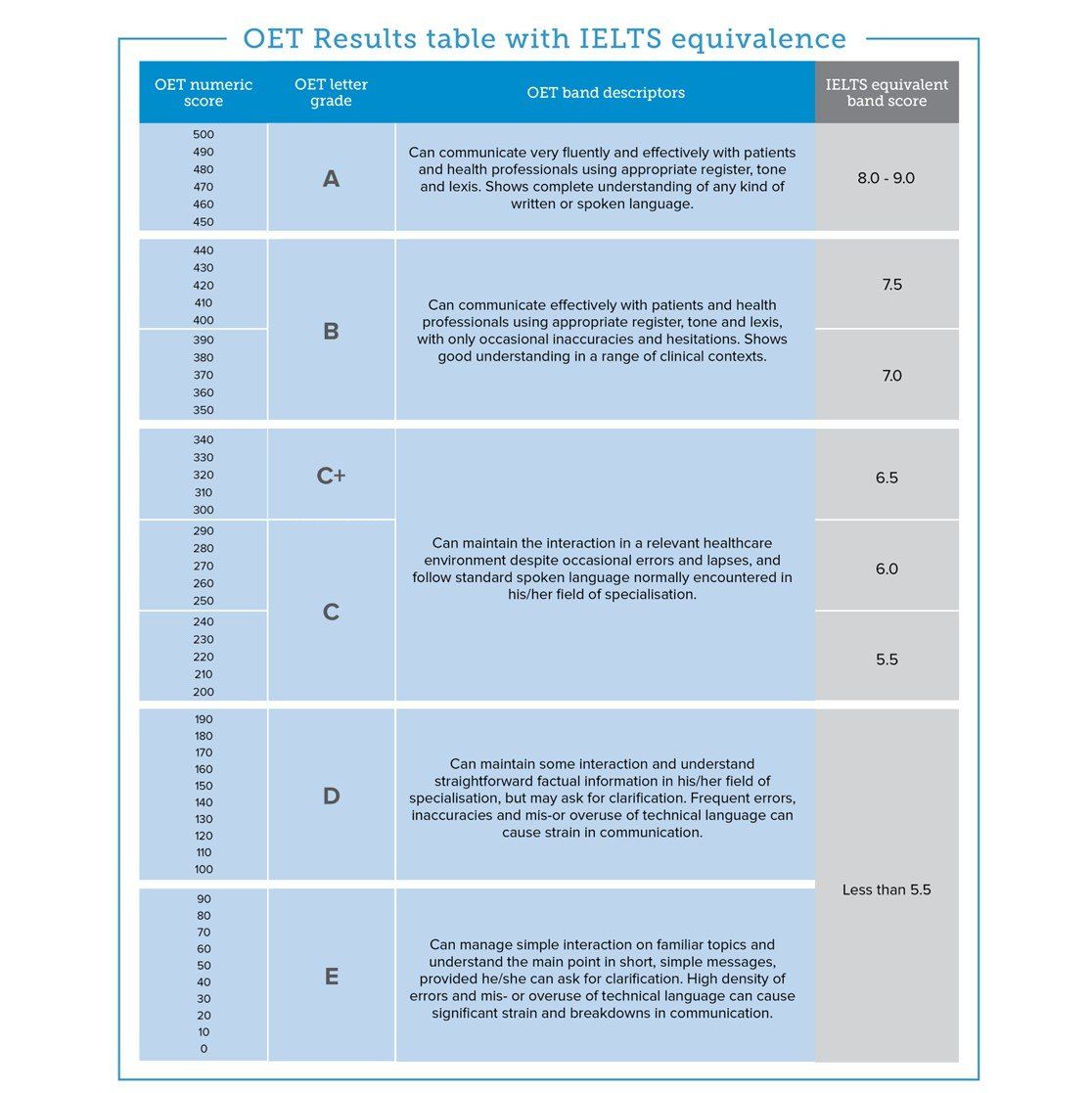Guide to the Occupational English Test for Healthcare Professionals
If you are a doctor or dentist planning to work in an English speaking country, you will need to pass a test of English language proficiency. The Occupational English Test (OET) is specially designed for the healthcare sector, authorised for use by 12 healthcare professions and accepted in 15 countries. This guide will help you decide if the OET is the right test for you.
What is the Occupational English Test?
The Occupational English Test (OET) is a test of English language proficiency and communication skills designed specifically for the healthcare sector. This differentiates it from other English proficiency tests which are generic and used across many industry sectors. It also restricts its use to candidates applying for employment or education within the healthcare clinical sector only. If you are applying for jobs out with the healthcare clinical setting, this test is of no practical use and you should select an alternative test of English language proficiency.
The OET is accepted for use by 12 healthcare professions to assess use of English language and communication skills appropriate to healthcare education, workplace communication with colleagues and clinical interactions with patients and their family members (or animal owners in tests for veterinarians).
The OET is accepted in 15 countries for professional registration, immigration and education. Before booking a test, you should verify if the OET is accepted by the appropriate organisation within the country and what format of the OET is required, as not all organisations accept the OET and some organisations accept only specific formats of the test.
Since 2013 OET has been owned by Cambridge Boxhill Language Assessment, a venture between Cambridge Assessment English and Box Hill Institute. Cambridge Assessment English is a not-for-profit department of the University of Cambridge with over 100 years of experience in assessing the English language. Box Hill Institute is a leading Australian vocational and higher education provider, active both in Australia and overseas.
Which Healthcare Professions Can Take the Occupational English Test?
The 12 clinical healthcare professions which use the OET are:
- Medicine
- Veterinary Science
- Dentistry
- Nursing
- Radiography
- Pharmacy
- Physiotherapy
- Dietetics
- Speech Pathology
- Podiatry
- Occupational Therapy
- Optometry
Who Recognises OET Results?
The OET is accepted in 15 countries of the world for four main purposes: immigration and visas, higher education within clinical healthcare disciplines, state registration of healthcare professions and healthcare employment.
The organisations which accept the OET and the format of the OET accepted vary considerably between countries so you should check the OET website for an up to date list before booking a test. Australia and the UK are the most enthusiastic acceptors of the OET with the test widely recognised for all four purposes. The remaining 13 countries have limited OET acceptance, which is mostly restricted to professional regulation and employment.
Australia
Government - The Department of Home Affairs recognises OET for various visa categories including skilled migration and student visas.
Healthcare Boards & Councils - Australian Health Practitioner Regulation Agency (AHPRA) National agency responsible for the registration and accreditation of 11 health professions in Australia accepts the OET. This includes the Paramedicine Board of Australia and Chinese Medicine Board of Australia. Other boards which accept the OET include the
Australian Institute of Medical Scientists (AIMS), Australian Dental Council and Australasian Veterinary Boards Council.
Universities and Higher Education Institutions - over 40 institutions recognise OET for healthcare courses.
Canada
The OET is accepted only for physician licensure and practice assessment programmes but is not accepted for visa and immigration purposes, employment or education or registration of other clinical professions.
Healthcare Boards & Colleges - 6 of the 13 Canadian Colleges of Physicians and Surgeons responsible for provincial physician licensing accept OET. The remaining 7 do not. The acceptors are the Colleges in Alberta, Newfoundland, Nova Scotia, Manitoba, British Columbia and Saskatchewan.
Practice Ready Assessment Programs - The Alberta International Medical Graduate Program and Practice Ready Assessment – British Columbia
Academic Programs - Alberta Health Services
Ireland
Healthcare Boards & Councils - The OET is accepted by the Royal College of Physicians of Ireland and regulatory organisations for physicians, dentists, nurses, pharmacists , dietitians, occupational therapists, physiotherapists, radiographers and radiation therapists, speech therapists and optometrists. It is not accepted for immigration, employment or educational purposes.
Maldives
Healthcare Boards & Councils -
the OET is accepted by the
Maldives Medical and Dental Council and the
Maldives Nursing and Midwifery Council, the two major healthcare professional regulators.
Malta
Healthcare Boards & Councils
The Council of Nurses and Midwives and the
Malta Medical Council are the two official regulatory organisations and both accept the OET.
Namibia
Healthcare Boards & Councils -
the
Health Professions Councils of Namibia accepts OET for all professional categories.
New Zealand
Government - Immigration New Zealand recognises the OET for most visa categories.
Healthcare Boards & Councils
- Dental Council of New Zealand
- Dietitians Board of New Zealand
- Medical Council of New Zealand
- Midwifery Council of New Zealand – all test types
- New Zealand Qualifications Authority (NZQA)
- Nursing Council of New Zealand
- Occupational Therapy Board of New Zealand
- Optometrists and Dispensing Opticians Board of New Zealand
- Pharmacy Council of New Zealand
- Physiotherapy Board of New Zealand
- Podiatrists Board of New Zealand
- Veterinary Council of New Zealand
Universities and Education
- accepted by over 20 universities and colleges of higher education
Philippines
Universities and Education - the OET is accepted by 4 higher education institutions
Qatar
The official language of Qatar is Arabic but English is widely spoken in the business and healthcare sectors. No official English proficiency test is required for the registration of professionals but employers may request testing.
Healthcare Providers - Hamad Medical Corporation Qatar's largest government sector health provider
Singapore
Healthcare Boards & Councils
- Singapore Dental Council
- Singapore Medical Council
- Singapore Pharmacy Council
- Allied Health Professions Council (AHPC)
The Allied Health Professions Council (AHPC) is a professional board which governs and regulates registered allied health professionals in Singapore. - AHPC – Occupational Therapy
- AHPC – Physiotherapy
- AHPC – Speech-language Therapy
- AHPC – Diagnostic Radiography and Radiation Therapy
Spain
Universities & Education - 2 universities accept OET
Ukraine
Healthcare Boards & Councils
- Ukrainian Council of Nursing and Midwifery
- Ukrainian Medical Council
- Ukrainian Professional Council of Public Health Services
United Kingdom
Government -
UK Visas and Immigration
Doctors and nurses in the UK are not required to take a separate English language test when applying for a Tier 2 (General) visa if they have provided OET results as proof of English proficiency to their healthcare regulator. This includes the Health and Care Worker visa which sits within the Tier 2 (General).
Healthcare Boards & Councils
- Academy of Medical Royal Colleges OET on paper only
- ENT UK – OET on paper only
- General Medical Council – all test types
- General Pharmaceutical Council – all test types
- Nursing and Midwifery Council – all test types
- Royal College of Anaesthetists – OET on paper only
- Royal College of Obstetricians and Gynaecologists – OET on paper only
- Royal College of Paediatrics and Child Health – all test types
- Royal College of Physicians of Edinburgh – OET on paper only
- Royal College of Physicians of London – OET on paper only
- Royal College of Psychiatrists – OET on paper only
- Royal College of Surgeons of England – OET on paper only
- Royal College of Veterinary Surgeons – OET on paper only
- The Royal College of Emergency Medicine – OET on paper only
- The Royal College of Opthalmologists – OET on paper only
- The Royal College of Pathologists – OET on paper only
- The Royal College of Surgeons of Edinburgh – OET on paper only
Universities & Education - 11 universities and higher education institutions accept the OET including King’s College London and Imperial College London
Employment - NHS Hospitals & Trusts
- Berkshire Healthcare NHS Foundation Trust – OET on Paper only
- Cambridgeshire and Peterborough NHS Foundation Trust – all test types
- Health Education England – all test types
- Wrightington, Wigan and Leigh Teaching Hospitals NHS Foundation Trust – OET on Paper only
- Yeovil District Hospital NHS Foundation Trust – OET on Paper only
United Arab Emirates
Healthcare Authorities - the organisations listed below are not professional licensing organisations any more, that function has been taken over by the Dubai Health Authority (DHA) and they offer education only.
United States of America
The OET is not accepted for immigration, employment or educational purposes and its use is limited to a registration with a few state nursing boards and credentialing companies the ECFMG/ FAIMER and CGFNS.
Healthcare Boards & Councils
- CGFNS International Inc – OET on Paper and OET on computer at a test venue
- Educational Commission for Foreign Medical Graduates|Foundation for Advancement of International Medical Education and Research (ECFMG®|FAIMER®) – all test types
- Florida Board of Nursing – OET on paper and OET on computer at a test venue
- Oregon State Board of Nursing – OET on paper and OET on computer at a test venue
- Washington State Nursing Care Quality Assurance Commission – all test types
- Michigan Department of Licensing and Regulatory Affairs – Health professions – all test types
- Massachusetts Board of Registration In Nursing – OET on Paper and OET on computer at a test venue
What is the OET assessment structure?
The OET covers all four language skills with an emphasis on communication in a healthcare environment. The test duration is just over 2 hours.
1: LISTENING - approx. 45 minutes
Same content for all healthcare professions.
Follow and understand a range of health-related spoken materials such as patient consultations and lectures.
Part A – consultation extracts (about 5 minutes each)
Part A assesses your ability to identify specific information during a consultation. You will listen to two recorded health professional-patient consultations and you will complete the health professional’s notes using the information you hear. Note: the health professionals may be any one of the 12 professions who can take OET.
Part B – short workplace extracts (about 1 minute each)
Part B assesses your ability to identify the detail, gist, opinion or purpose of short extracts from the healthcare workplace. You will listen to six recorded extracts (e.g. team briefings, handovers, or health professional-patient dialogues) and you will answer one multiple-choice question for each extract.
Part C – presentation extracts (about 5 minutes each)
Part C assesses your ability to follow a recorded presentation or interview on a range of accessible healthcare topics. You will listen to two different extracts and you will answer six multiple-choice questions for each extract. You may expect two presentations or two interviews, or one of each.
How is listening ability assessed in OET?
The OET Listening sub-test is designed to assess a range of listening skills, such as identifying specific information, detail, gist, opinion or the speaker’s purpose. These skills are assessed through note-completion tasks and multiple-choice questions.
Assessors who mark the Listening sub-test are qualified and highly trained. Candidate responses are assessed against an established marking guide. During the marking session, problematic or unforeseen answers are referred to a sub-group of senior assessors for guidance and all papers are double-marked to ensure fairness and consistency.
How is the Listening sub-test scored?
Your answers for OET Listening Part A are double-marked by trained OET assessors.
These answers are randomly assigned to assessors to avoid any conflict of interest.
Your answers for Part B and Part C are computer scanned and automatically scored.
For Part A, Listening assessors use a detailed marking guide which sets out which answers receive marks. Assessors use this guide to decide whether you have provided enough correct information to be given the mark. Assessors are monitored for accuracy and consistency.
2: READING - 60 minutes
Same content for all healthcare professions.
Read and understand different types of text on health-related subjects
Part A – expeditious reading task (15 minutes)
Part A assesses your ability to locate specific information from four short texts in a quick and efficient manner. The four short texts relate to a single healthcare topic, and you must answer 20 questions in the allocated time period. The 20 questions consist of matching, sentence completion and short answer questions.
Part B and Part C – careful reading tasks (45 minutes)
Part B assesses your ability to identify the detail, gist or main point of six short texts sourced from the healthcare workplace (100-150 words each). The texts might consist of extracts from policy documents, hospital guidelines, manuals or internal communications, such as emails or memos. For each text, there is one three-option multiple-choice question.
Part C assesses your ability to identify detailed meaning and opinion in two texts on topics of interest to healthcare professionals (800 words each). For each text, you must answer eight four-option multiple choice questions.
How is reading ability assessed in OET?
Reading Part A (the expeditious reading task) tests your ability to skim and scan quickly across different texts on a given topic in order to locate specific information. For that purpose, Part A is strictly timed and you must complete all 20 question items within the allocated 15 minutes. To complete the task successfully, you will also need to understand the conventions of different medical text types and understand the presentation of numerical and textual information.
Reading Part B tests your ability to understand the detail, gist or main point of complex texts commonly found in the healthcare workplace. To complete the task successfully, you will need to identify specific ideas at sentence level.
Reading Part C tests your ability to understand the explicit or implied meaning as well as the attitude or opinion presented in a longer text. To complete the task successfully, you will need to identify the relationship between ideas at sentence and paragraph level. Part C also tests your ability to accurately understand lexical references and complex phrases within the text.
Assessors who mark the Reading sub-test are qualified and highly trained. Candidate responses are assessed against an established marking guide. During the marking session, problematic or unforeseen answers are referred to a sub-group of senior assessors for guidance.
3: WRITING -45 minutes
Specific to profession, based on typical workplace situations.
- The task is to write a letter, usually a referral letter. Some alternative letter types are a letter of transfer and a letter of discharge. A letter to advise or inform a patient, carer or group is sometimes used in Pharmacy, Veterinary Science and occasionally for Speech Pathology and Occupational Therapy. Another task variation, with a different focus, is a written response to a complaint (for Radiography).
- Along with the task instructions, you will receive stimulus material (case notes and/or other related documentation) which includes information to use in your response.
How is writing ability assessed in OET?
Your performance on the Writing sub-test is marked independently by a minimum of two trained Assessors. Neither Assessor knows what scores the other has given you, or what scores you have achieved in any of the other sub-tests.
Your performance is scored against six criteria and receives a band score for each criterion:
- Purpose (Whether the purpose of the letter is immediately apparent to the reader and sufficiently expanded in the course of the letter)
- Content (Whether all the necessary information is included and accurate for the reader)
- Conciseness & Clarity (Whether unnecessary information is omitted so that the letter is an effective summary for the reader)
- Genre & Style (Whether the register, tone and use of abbreviations are appropriate for the reader)
- Organisation & Layout (Whether the letter is organised and well laid out for the reader)
- Language (Whether the accuracy of the grammar, vocabulary, spelling and punctuation communicates the necessary information to the reader)
4: SPEAKING - approx. 20 minutes
Specific to profession, based on typical workplace situations.
In a private room you will take part in two role-plays. You take your professional role (as a healthcare professional) while the interlocutor plays a patient or client, or sometimes a relative or carer or animal owner.
Your performance on each of the two Speaking role-plays is scored against nine criteria and receives a band score for each criterion. The nine criteria are separated into two different segments: Linguistic and Clinical Communication.
Linguistic Criteria:
- Intelligibility: The impact of your pronunciation, intonation and accent on how clearly your listener can hear and understand what you’re saying
- Fluency: The impact of the speed and smoothness of your speech on your listener’s understanding
- Appropriateness of Language: The impact of your language, tone and professionalism on your listener’s understanding and comfort
- Resources of Grammar and Expression: The impact of your level of grammatical accuracy and vocabulary choices on your listener’s understanding.
Clinical Communication Criteria:
- Relationship-building: The impact of your choice of opening to the conversation and demonstration of empathy and respect on your listener’s comfort
- Understanding and incorporating the patient’s perspective: The impact of how fully you involve the patient in the conversation on your listener’s understanding and comfort
- Providing structure: The impact of how you organise the information you provide and introduce new topics for discussion on your listener’s understanding
- Information-gathering: The impact of the type of questions you ask and how you listen to the responses on your listener’s understanding
- Information-giving: The impact of how you provide information and check this information is being understood on your listener’s comfort and understanding.
What are the OET Test Types?
There are three test types which can be taken but the first option, the paper test taken at a test venue is the one favoured and most commonly accepted by healthcare regulators, governments, employers and universities.
- OET on Paper at a Test Venue
- OET on Computer at a Test Venue
- OET@Home
How Can I book an OET Test?
All types of OET Tests can be booked on the OET website with a choice of dates and venues. The website also contains useful extensive material to help with test preparation including a preparation portal, study guide, events, practice tests and lots of tips.
How and When are the OET Results Issued?
The test results are available approximately 16 business days after your test day and are available via your online profile on the OET website. You can see an overview of your latest test scores and official copies of Statements of Results can be downloaded from your online profile.
How is the OET Test Marked?
There is no overall grade for OET. The four sub-tests that make up the OET are reported on a scale from 0 to 500 in ten-point increments (e.g. 350, 360, 370 etc). The numerical score will be mapped to a separate letter grade for each sub-test ranging from A (highest) to E (lowest).
Listening and Reading
Your answer booklets for Listening Part A and for Reading Part A are marked by trained OET Assessors. These answer booklets are assigned to OET Assessors at random to avoid any conflict of interest. Your answer booklets for Reading and Listening Parts B and C are computer scanned and automatically scored.
Listening and Reading Assessors use a detailed marking guide which sets out which answers receive marks and how the marks are counted. Assessors use this guide to decide for each question whether you have provided enough correct information to be given the mark or marks available. Assessors are monitored for accuracy and consistency, and your Part A answers are marked by at least two different assessors.
Writing and Speaking
Your performances on the Writing and Speaking sub-tests are each rated by at least two trained Assessors. Audio files and scripts are assigned to Assessors at random to avoid any conflict of interest. Your test-day Interlocutor is not involved in the assessment process.
Writing and Speaking Assessors are monitored for accuracy and consistency, and the scores they award are adjusted to take into account any leniency or severity. If two Assessors award different scores to your performance, your script and/or audio file will be referred to at least one other senior Assessor not previously involved in your assessment.
For the Writing sub-test, each Assessor scores your performance according to six criteria: Purpose, Content, Conciseness & Clarity, Genre & Style, Organisation & Layout, and Language. Each criterion is assigned a band score from 0 to 7, except Purpose, which has a band score of 0 to 3. A score of 350 (previously grade B) for Writing requires a high level of performance on all six criteria.
For the Speaking sub-test, each Assessor scores your performance according to nine criteria. The four linguistically-oriented criteria are Intelligibility, Fluency, Appropriateness of Language, and Resources of Grammar and Expression. They are assessed on a scale from 0 to 6. Clinical communication criteria include Indicators of Relationship Building, Indicators of Understanding & Incorporating the Patient’s Perspective, Indicators of Providing Structure, Indicators for Information Gathering and Indicators for Information Giving. They are assessed on a scale from 0 to 3. A high level of performance on all nine criteria is required in order to achieve a score of 350 (previously grade B) on the speaking test.

For How Long is the OET Valid?
The OET has no expiry date but most organisations accepting the OET will specify a validity of two years from the date of issue of the report, after which you will need to retake the exam.
Further Information About Tests of English Language Proficiency
2 September 2022
Share this post on Social Media
Leave a Comment
SEARCH JOBS
Ready for a change? Whether you’re looking for higher compensation, greater autonomy, a better work-life balance, or just a change in scenery, we have job opportunities in wonderful locations across the world. Start your medical or dental job search today and embark on your next career move.
SIGN UP FOR JOB ALERTS
We believe everyone deserves to find their dream job. Be the first to hear about new practice opportunities in exciting locations across the world Simply sign up for job alerts in your chosen field, and we will email you when a new job in your specialty becomes available.




















